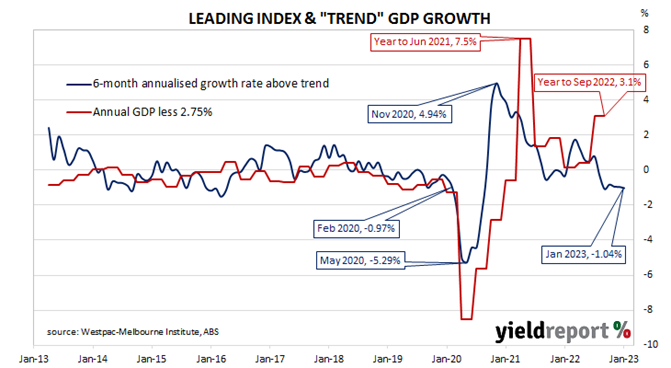Summary: Leading index growth rate up a little in January; points to below-trend growth in 2023; Westpac expects economy to “stall” in second half; reading implies annual GDP growth of around 1.75%; ACGB yields higher; rate-rise expectations soften.
Westpac and the Melbourne Institute describe their Leading Index as a composite measure which attempts to estimate the likely pace of Australian economic growth in the short-term. After reaching a peak in early 2018, the index trended lower through 2018 and 2019 before plunging to recessionary levels in the second quarter of 2020. Subsequent readings spiked towards the end of 2020 but then trended lower through 2021 and 2022.
The January reading of the six month annualised growth rate of the indicator registered -1.04%, up a little from December’s figure of -1.09% after it was revised down from -0.97%.
“This marks the sixth consecutive month that the growth rate has been negative,” said Westpac Chief Economist Bill Evans. “The Index continues to point to below-trend growth over the next 3-9 months. Westpac concurs with that view, with growth in the Australian economy expected to slow to stalling speed by the second half of 2023.”
Index figures represent rates relative to “trend” GDP growth, which is generally thought to be around 2.75% per annum in Australia. The index is said to lead GDP by “three to nine months into the future” but the highest correlation between the index and actual GDP figures occurs with a three-month lead. The current reading thus represents an annual GDP growth rate of around 1.75% in the next quarter.
Domestic Treasury bond yields increased moderately, lagging the noticeable rises of US Treasury yields overnight. By the close of business, the 3-year ACGB yield had added 2bps to 3.59%, the 10-year yield had gained 6bps to 3.88% while the 20-year yield finished 4bps higher at 4.22%.
In the cash futures market, expectations regarding future rate rises softened. At the end of the day, contracts implied the cash rate would rise from the current rate of 3.33% to average 3.50% in March and then increase to an average of 3.905% in May. August contracts implied a 4.21% average cash while November contracts implied 4.205%.


